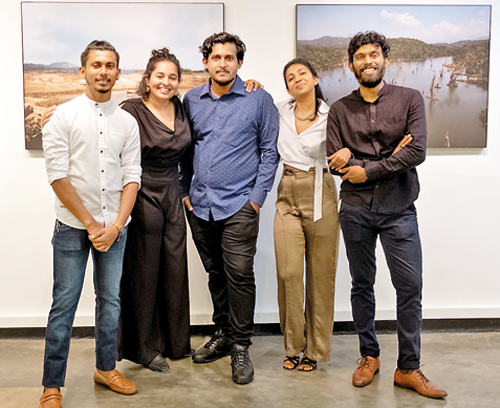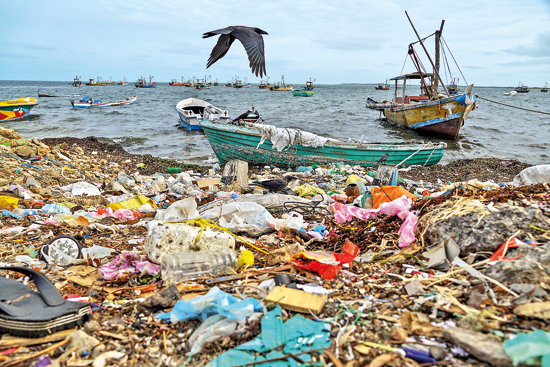Photographs that make you stop and take heed

The group of photographers at the exhibition launch on Thursday
If you were to walk into the Harold Pieris Gallery at the Lionel Wendt in the coming week, the first object to meet your eye is a large photograph of buffalo grazing through mounds of garbage, surrounded by a flurry of crows. The photograph is transferred onto a glass window and looms large. Firstly, there is a visual shock – when you’re used to consuming images of pollution and poor waste management through pixelated images on social media or a small printed photograph sandwiched in a newspaper, it is jarring to see it enlarged in this manner. It forces the viewer to stop and take heed.
The photograph is a part of Ramanathan Parilojithan’s photo series which explores the impact of dumping garbage and medical waste along the Batticaloa lagoon on the surrounding families who are dependent on fisheries. While Ramanathan, unsupported, has been documenting the adverse environmental effects on communities since 2018, the grant and mentoring he received as a part of the current exhibition helped him delve deeper into the issue.
For a year, Ramanathan followed David, a fisherman in Batticaloa, documenting how his livelihood and surroundings had been impacted by the dumping of medical waste in the vicinity. David’s family is one of 56 families in the area affected by this. Ramanathan’s photographs foreground aspects of everyday life in the area: close-ups of glass tubes, cotton wool blotted with blood, syrup bottles washed along the lagoon; a fisherman in repose; a meal.
The photographs are a part of the Humanity & Earth exhibition currently on display at the Harold Pieris Gallery at the Lionel Wendt. The exhibition marks the conclusion of a two-year project by the Goethe-Institut Sri Lanka where two photographers from Germany mentored and worked with a small group of emerging photographers from around the island, who were interested in ecological themes. The project began in May 2018 with a road trip around the island to areas of environmental interest such as the Port city, the collapsed Meethotamulla landfill, the Norochcholai coal power plant and the analog forest project in Bellipola. Both mentors, Andy Spyra and Liz Fernando, came from different backgrounds – photojournalism and fine arts – and each evening resulted in knowledge sharing and a dissection and feedback session of the day’s photographs among all participants.

Tharmapalan Tilaxan: Co-existing with garbage
The photographers were then encouraged to focus on a specific project for a year and seed grants were awarded to fund logistics and field visits for these projects The group reconvened in May 2019 for a seven-day master class in Unawatuna, supervised by the mentors. The master class provided an opportunity for the participants to showcase what they had been working on, hold their work up for discussion and analysis and gave them the space to focus on their projects outside their everyday routines.
This long-term, detailed engagement had different effects on the photographers’ creative practice. “The most important thing is that I learned how to view a photograph,” explained Sandranathan Rubatheesan, a freelance journalist at the Sunday Times who picked up photography as a hobby and tells interesting stories from around the island with a phone and a compact camera. The project helped him delve into the thinking process, technical details, composition and interpretation of a photograph and then translate the learning into his photo practice and journalism.
Shehan Obeysekara and Munira Mutaher left the master class with photographs from a year’s worth of field visits whittled down to just four images between them. In one sense, it sent them back to the drawing board and encouraged them to push their visual boundaries with the project but it also embedded significant changes to their creative practice in the long run. For the duo, the two-year-long engagement enabled them to think about depth and layers within a photograph and pushed them to tell complicated stories through images.
The exhibition succeeds with a few things. First, it demonstrates what long-term engagement and critical thinking about a subject can result in. It is also a much-needed reminder of the kind of creative alchemy that can take place when there is mentorship, financial resources, time and space given to emerging creative practitioners in Sri Lanka. This kind of engagement isn’t easy to pull off and sustain, and the mentors, participants and the Goethe-Institut should be congratulated on the exhibition’s ability to tell environmental stories with nuance. There’s care and thought behind the photographs and stories on display, and instead of being didactic with the topic, it encourages curiosity.
It succeeds in taking on a vast theme (humanity and earth is a too broad, all-encompassing theme) and balances the beauty, potential, uneasiness and anguish at the way Sri Lankans interact with their surroundings. Even as Tharmapalan Tilaxan’s evocative photo series on how the residents in Gurunagar live amongst piles of garbage and plastic waste dumped in the area will make you despair at the injustice of fellow Sri Lankans being forced to ‘co-exist’ with garbage, Tashiya de Mel’s stunning, stark photographs of Sri Lanka’s landscapes are a reminder of how intensely beautiful this country can be. And this hope, this discomfort is so important if we are to reflect and significantly rethink the ways in which we engage with our world.
Humanity & Earth features photographs by Tashiya De Mel, Munira Mutaher, Sandranathan Rubatheesan, Tharmapalan Tilaxan, Ramanathan Parilojithan and Shehan Obeysekara.
The exhibition is on till September 13 from 10 a.m. to 7 p.m.at the Harold Pieris Gallery at the Lionel Wendt Arts Centre. For more details https://www.humanityandearth.co/


